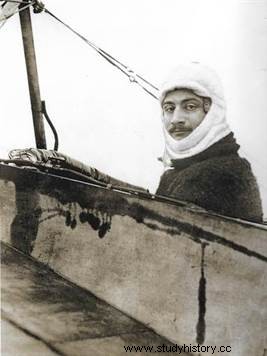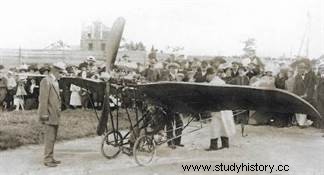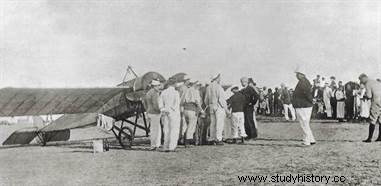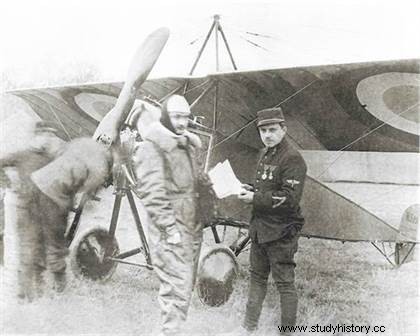 Roland Garros (1888-1918) was a brilliant French aviator and officer from the beginnings of aeronautics, who made the first aerial crossing of the Mediterranean Sea in 1913. He was also the holder, on several occasions, of the world record for altitude flight . Engaged in the first aerial combats in history, his plane was shot down in 1915. Taken prisoner by the Germans, he managed to escape and was incorporated into the Storks squadron. He was killed in aerial combat at the end of the First World War. The Roland-Garros stadium (so named in homage to the aviator) hosts the French Open tennis tournament every May-June.
Roland Garros (1888-1918) was a brilliant French aviator and officer from the beginnings of aeronautics, who made the first aerial crossing of the Mediterranean Sea in 1913. He was also the holder, on several occasions, of the world record for altitude flight . Engaged in the first aerial combats in history, his plane was shot down in 1915. Taken prisoner by the Germans, he managed to escape and was incorporated into the Storks squadron. He was killed in aerial combat at the end of the First World War. The Roland-Garros stadium (so named in homage to the aviator) hosts the French Open tennis tournament every May-June.
Roland Garros, a passion for aviation
Roland Garros was born in Saint-Denis de la Réunion on October 6, 1888 to a lawyer father. In 1900 he was sent to France to continue his studies. More driven by outdoor physical activities than by studies, he nevertheless joined the Ecole des Hautes Etudes Commerciales (HEC) in 1906. His training completed, he became a salesman for Grégoire automobiles, then opened his own business. He then designed a two-seater cart for a young and wealthy clientele.
 His interest in aeronautics comes from reading Jules Verne. He attended many air meetings and aeronautical shows and ended up acquiring a replica of Santos-Dumont's "damsel" in 1910. A first flight ended in a collision with another aircraft:that of Maurice Clément . The latter is none other than the son of the manufacturer of the replica of the aircraft, and he generously offers a new machine. The second attempt will be the right one, with a perfect flight in a straight line. Intoxicated and radiant, Garros is decided:he will be an aviator.
His interest in aeronautics comes from reading Jules Verne. He attended many air meetings and aeronautical shows and ended up acquiring a replica of Santos-Dumont's "damsel" in 1910. A first flight ended in a collision with another aircraft:that of Maurice Clément . The latter is none other than the son of the manufacturer of the replica of the aircraft, and he generously offers a new machine. The second attempt will be the right one, with a perfect flight in a straight line. Intoxicated and radiant, Garros is decided:he will be an aviator.
Roland Garros obtained his first exhibition contract in Cholet on July 14, 1910, although he did not yet have his patent. He will take part in many meetings all over France. It was then that Santos-Dumont, forced to give up flying for medical reasons, offered to sell him his Demoiselle. A dream for Garros who, with the original, achieved more spectacular flights at more than 200 meters, a record for the time. Wherever he performs, he receives an enthusiastic welcome and the young hero becomes a recognized driver, enough to win a contract for a meeting in the United States.
Roland Garros exhibitions and exploits
He sailed for New York on October 11, 1910 to take part in a rally at Belmont Park. He then performs numerous exhibitions which lead him throughout North America. But his Demoiselle is no longer enough for him. He returned to France to find a machine more suited to his ambitions. He found in Louis Blériot the partner he needed and participated brilliantly in many races, including the Paris-Rome. In 1912, he won the Grand Prix de l'Aéroclub de France, then went on to set world altitude records, notably during a tour of South America.
 On September 23, 1913, he achieved a feat by making the first crossing of the Mediterranean, rallying Fréjus to Bizerte in Tunisia. This 780 kilometer flight performed on a Morane Saulnier monoplane will definitively establish his fame.
On September 23, 1913, he achieved a feat by making the first crossing of the Mediterranean, rallying Fréjus to Bizerte in Tunisia. This 780 kilometer flight performed on a Morane Saulnier monoplane will definitively establish his fame.
An airman in the war
Born overseas, Roland Garros was not called up when war broke out in the summer of 1914. No matter, he enlisted as a simple soldier on August 4. Naturally assigned to a squadron, he carried out numerous reconnaissance, hunting and bombing missions. Roland Garros also perfected the system of firing the machine guns of fighter planes of the time:firing through the propeller, developed by Raymond Saulnier.
He achieved many aerial victories before being shot down in April 1915 and taken prisoner by the Germans. Having been unable to set fire to his plane, the latter's firing system will be carefully studied by the enemy who will try to copy it, without success, and will end up opting for another system (Fokker). Garros escaped from his prison camp at the end of 1917 and managed to return to France. Refusing Clemenceau's proposal to become an adviser to the general staff, he returned to combat, assigned to the prestigious Cigognes squadron.
 On October 5, 1918, his plane exploded in the air during a clash in the Ardennes, not far de Vouziers where he will be buried. In 1927, his friend Emile Lesieur, who had become president of the Stade Français, imposed the name of Roland Garros for the construction of the stadium responsible for hosting the Davis Cup. Every year, the Roland Garros tournament perpetuates the memory of this flying ace.
On October 5, 1918, his plane exploded in the air during a clash in the Ardennes, not far de Vouziers where he will be buried. In 1927, his friend Emile Lesieur, who had become president of the Stade Français, imposed the name of Roland Garros for the construction of the stadium responsible for hosting the Davis Cup. Every year, the Roland Garros tournament perpetuates the memory of this flying ace.
Bibliography
- Memoirs, by Roland Garros. Phebus Editions, 2016.
- Roland Garros:Such a Famous Unknown, biography of Georges Fleury. Bourrin, 2009.
